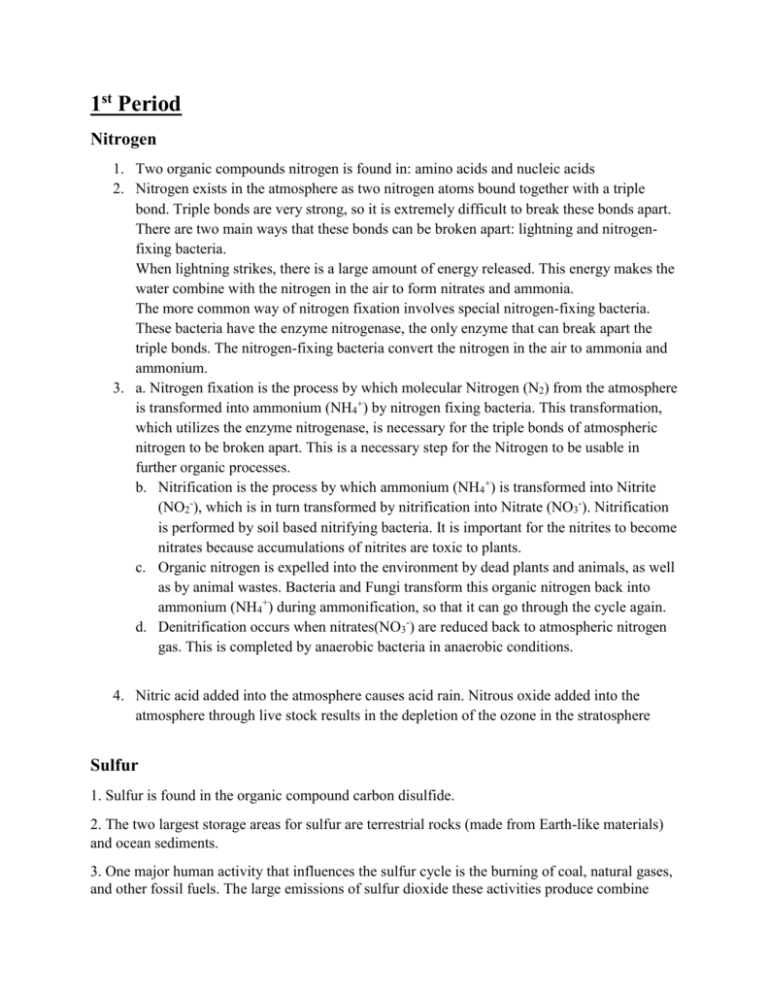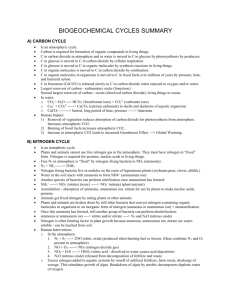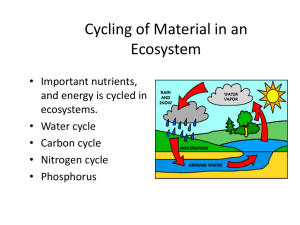Biogeochemical Answer Document- All Classes
advertisement

1st Period Nitrogen 1. Two organic compounds nitrogen is found in: amino acids and nucleic acids 2. Nitrogen exists in the atmosphere as two nitrogen atoms bound together with a triple bond. Triple bonds are very strong, so it is extremely difficult to break these bonds apart. There are two main ways that these bonds can be broken apart: lightning and nitrogenfixing bacteria. When lightning strikes, there is a large amount of energy released. This energy makes the water combine with the nitrogen in the air to form nitrates and ammonia. The more common way of nitrogen fixation involves special nitrogen-fixing bacteria. These bacteria have the enzyme nitrogenase, the only enzyme that can break apart the triple bonds. The nitrogen-fixing bacteria convert the nitrogen in the air to ammonia and ammonium. 3. a. Nitrogen fixation is the process by which molecular Nitrogen (N2) from the atmosphere is transformed into ammonium (NH4+) by nitrogen fixing bacteria. This transformation, which utilizes the enzyme nitrogenase, is necessary for the triple bonds of atmospheric nitrogen to be broken apart. This is a necessary step for the Nitrogen to be usable in further organic processes. b. Nitrification is the process by which ammonium (NH4+) is transformed into Nitrite (NO2-), which is in turn transformed by nitrification into Nitrate (NO3-). Nitrification is performed by soil based nitrifying bacteria. It is important for the nitrites to become nitrates because accumulations of nitrites are toxic to plants. c. Organic nitrogen is expelled into the environment by dead plants and animals, as well as by animal wastes. Bacteria and Fungi transform this organic nitrogen back into ammonium (NH4+) during ammonification, so that it can go through the cycle again. d. Denitrification occurs when nitrates(NO3-) are reduced back to atmospheric nitrogen gas. This is completed by anaerobic bacteria in anaerobic conditions. 4. Nitric acid added into the atmosphere causes acid rain. Nitrous oxide added into the atmosphere through live stock results in the depletion of the ozone in the stratosphere Sulfur 1. Sulfur is found in the organic compound carbon disulfide. 2. The two largest storage areas for sulfur are terrestrial rocks (made from Earth-like materials) and ocean sediments. 3. One major human activity that influences the sulfur cycle is the burning of coal, natural gases, and other fossil fuels. The large emissions of sulfur dioxide these activities produce combine with the atmosphere to create acid rain. Another use for sulfur is for both human and plant growth. Sulfur is in two major amino acids (methionine and cysteine) that is a dietary requirement for humans. Humans take in about 900 mg of sulfur everyday, usually in the form of protein. Sulfur is imperative to plant growth as well. We use sulfur in many fertilizers to motivate healthy growth. Phosphorus 1. Phosphorus is found in many organic compounds that are RNA, DNA, ATP, ADP, and NADP (Nicotinamide Adenine Dinucleotide Phosphate). 2. Phosphorus does not circulate in the troposphere to a great extent because there are no gaseous forms of phosphorus and is only found in the atmosphere are small dust particles. 3. Terrestrial rocks, ocean sediments, plants and microbes, and water are the largest sinks for phosphorus. 4. Phosphorus is usually found in the ionic form of PO 4^3- and HPO 4^2 usually used for nutrients for animals and plants. 5. The phosphate are also limiting factors for plant growth in marine ecosystems because they are not very water soluble. The eutrophication kicks in where there is too much phosphate it increases the amount of algae growth and it depletes the amount of dissolved oxygen. 6. Mining phosphate rock, deforestation, animal wastes from livestock, commercial phosphate fertilizers in agricultural areas, and discharge of municipal sewage/wastewater treatment facilities are all human effects. Mining phosphate rock adds phosphate to water systems in a form called runoffs. Deforestation refuses the amount of phosphate in the soil. Animal wastes from livestock feedlots, commercial phosphate fertilizer in agricultural areas, and discharge of municipal sewage/wastewater treatment facilities all increase the amount of phosphate in the soil and in local fresh water that we drink. Carbon 1. Four organic compounds containing carbon are calcium carbonate(CaCO3), carbonate (CO32-), carbon dioxide (CO2), bicarbonate (HCO3-). bicarbonate is from carbon dioxide being dissolved in water. 2. Carbon dioxide comprises approximately .04% of tropospheric gases. 3. Carbon dioxide is significant to Earth’s “natural thermostat” because fossil fuels, which are made when the decay process of carbon is interrupted, when burned release CO2. With this increase in CO2 the atmospheric percent of CO2 increases which contributes to the greenhouse effect causing the Earth to be warmer. 4. The two processes that have the greatest influence on the concentration of CO2 are the diffusion of CO2 from the atmosphere into the oceans and the Burning of fossil fuels.The diffusion decreases the amount of carbon dioxide because it is soluble in water so it pulls the carbon from the atmosphere. The burning of fossil fuels increases the concentration because it releases carbon back into the air faster than it is being used to create the fossil fuels. 5. The two largest sinks for carbon are oceans and forests. 6. Marine plants take in large amounts of carbon in order to undergo photosynthesis. Photosynthesis requires a lot of carbon therefore returning the CO2 back into the atmosphere. 7. Two major anthropogenic interventions in the carbon cycle include: -humans reducing the amount of trees faster than they can reproduce -carbon being emitted into the atmosphere after humans burn fossil fuels and other things such as wood. 5th Period Nitrogen 1) Nitrogen is found in nucleic and amino acids (protein and DNA) 2) Nitrogen is fixed through lightning and biological fixation. The lightning is a form of atmospheric fixation. The energy of the lightning breaks the nitrogen molecules apart and these molecules combine with oxygen in the air to form nitrogen oxides. The biological fixation is the ability to fix nitrogen through certain bacteria. This requires a complex set of enzymes and a lot of ATP. The bacteria produce ammonia which is incorporated into protein and other nitrogen compounds. 3) a) Nitrogen fixation is where nitrogen is converted to ammonium so that it can be biologically available. Atmospheric nitrogen is very stable so it is difficult to break its bonds and have it react with other chemicals to form new compounds. Nitrogen fixation is essential to break apart the bonds and free up the nitrogen atoms so that they can form new compounds. Fixation can occur through a multitude of mediums. Some of these mediums include lightning and bacteria. The energy from lightning reacts with water (H2O) and nitrogen gas (N2) to form nitrates (NO3) and ammonia (NH3). These compounds are carried to the ground through precipitation, where they can now be biologically available and usable. Chemical Reaction: N2 + 3 H2 → 2 NH3 b) Nitrification is the process of oxidizing the ammonia (NH3) and ammonium (NH4+) that has been created to form nitrite. Oxidation is the loss of electrons in an element during a reaction by a molecule, ion or atom. Nitrosomonas bacteria turn nitrogen into nitrite (NO2-) and nitrobacter bacteria convert the nitrite to nitrate (NO3-) through the oxidation process. These two processes are called nitritation and nitratation. They are both aerobic processes performed by bacteria. These reactions occur slowly because of the slow growth rates of the bacteria involved in the process. Chemical Reactions: 2 NH3 + 3 O2 → 2 NO2 + 2 H+ + 2 H2O and 2 NO2- + O2 → 2 NO3c) Ammonification occurs when a plant or animal dies or an animal excretes waste. This form of nitrogen is organic, and microorganisms found in soil and water break down the proteins and amino acids. They oxidize them to convert the nitrogen in the waste/remains into ammonia (NH3). Ammonia is then retained in soil or water in the form of the ammonium ion (NH4+), so ammonification takes the nitrogen in waste and transforms it into ammonia and ammonium. It is an extremely important stage in the nitrogen cycle because after the ammonium is produced, groups of microorganisms can convert it into nitrate, which is absorbed by plants, allowing the cycle to keep repeating. It is also critical because without Sulfur Cycle 1. Organic compounds that contain sulfur include amino acids, enzymes, vitamins, and hormones. Many organic compounds that contain sulfur are associated with having a foul smell. 2. The two largest storage areas for sulphur are terrestrial rocks and ocean minerals. 3. Two major human activities that influence the sulfur cycle include burning sulfur contains coal and mining for coal and metals. Phosphorus 1.) ATP, DNA/RNA, (Phospho)lipids 2.) Soil conditions do not allow bacteria to convert chemical forms of phosphorous into gaseous forms. Phosphorous is only found in the atmosphere as particles of dust. 3.) Ocean Sediment and Terrestrial Rock 4.) Phosphate (PO43-) 5.) Eutrophication, or a rapid increase in plant life (usually algae), often occurs when phosphate compounds are added to aquatic areas. Phosphate is a limiting nutrient for plants, and so when large quantities of phosphate are added to aquatic environments, algal blooms occur. Algae increase the temperature of the water (via photosynthesis), but decreases the levels of dissolved oxygen. When algae dies/decomposes, the turbidity and BOD of the water increase as well. This could result in a dead zone. 6a.) Mining exposes land that has phosphorus in it, and when the land with phosphorus erodes, the phosphorus is spread to nearby plants and bodies of water, increasing phosphorus distribution and uptake by plants. 6b.) Animals consume large quantities of plants, and plants contain large quantities of phosphorus. When animal feces are exposed to the environment, they are usually carried into water via runoff, where the phosphorus in the feces is dissolved in the water. The phosphorus is then redistributed throughout the environment, but if large quantities of phosphorus are taken up by plants, eutrophication could result. 6c.) The fertilizer that is not absorbed by plants is either absorbed by the soil or carried into aquatic ecosystems via runoff. The phosphorus in the fertilizers is then dissolved in the water, and redistributed throughout the environment (via sedimentation or uptake by aquatic plants). If large quantities of phosphorus are taken up by plants, algal blooms could result. 6d.) Discharge from sewage/water treatment facilities can contain large quantities of phosphorus that flow directly into aquatic ecosystems. The phosphorus in the waste is then dissolved in the water, and once again cycles throughout the environment, potentially causing eutrophication. Carbon 1. 2. 3. 4. 5. 6. 7. Carbon is found in carbohydrates, lipids, protein, and nucleic acids. Carbon Dioxide comprises approximately .04% of today’s tropospheric gases. This is the lowest of all gas concentrations of the troposphere. Carbon dioxide is the single most important climate-relevant greenhouse gas in Earth’s atmosphere. This is because CO2 does not condense and precipitate from the atmosphere at current climate temperatures, whereas water vapor does. Non condensing greenhouse gases, which account for 25% of the total terrestrial greenhouse effect, serve to provide the stable temperature structure that sustains the current levels of atmospheric water vapor and clouds via feedback processes that account for the remaining 75% of the greenhouse effect. Without the radiative forcing supplied by CO2 and the other non condensing greenhouse gases, the terrestrial greenhouse would collapse, plunging the global climate into an icebound Earth state. Diffusion of CO2 in the atmosphere into the ocean because it is readily soluble in water and is removed by photosynthesizing producers. Burning of fossil fuels because we are taking a resource/reservoir that took millions of years to form and adding it to the atmosphere in a faster than it can reproduce. Ocean sediments and continental rocks The oceans play an important role in regulating the amount of CO2 in the atmosphere because CO2 can move quickly into and out of the oceans. Once in the oceans, the CO2 no longer traps heat. Approximately 93 percent of the CO2 is found in the oceans. Humans deplete trees that store CO2 faster than they can reproduce. We add too much CO2 to the atmosphere through burning fossil fuels and wood. 7th Period Nitrogen Cycle 1. Nitrogen is found in 2 organic compounds: nucleic and amino acids. 2.The 2 major ways nitrogen is "fixed" is through lightning and biological fixation 3.a: In nitrogen fixation, specialized bacteria in soil and aquatic environments convert gaseous nitrogen to ammonia and then ammonia to ammonium ions. These ions are then usable to plants. N2 -> NH3 -> NH4+ 3.b: Nitrification is the process that happens when ammonia and ammonium are not taken in by plants. Specialized soil bacteria convert most of ammonia and ammonium in the soil to nitrite ions which are then converted into Nitrate ions, to be useable by plants. NH3 -> NO2- -> NO33.c: In ammonification, groups of specialized decomposer bacteria like fungi or bacteria turn nitrogen back into ammonium so it can reenter the nitrogen cycle. N2 -> NH4+ 3.d: In denitrification, extra nitrogen from the soil goes back into the air through denitrifying bacteria. NH3 -> NH4+ -> N2 4. One anthropogenic interventions in the nitrogen cycle is when we add nitric acid into the atmosphere which then leads to acid rain. Another intervention is that we add nitrous oxide into the atmosphere through things like livestock which later deplete the ozone in the stratosphere. Sulfur 1. H2S, SO2, SO42-, and CH3SCH3 are all organic compounds in which sulfur is found. SO42- is found in sea spray, CH3SCH3 is found in certain marine algae, and, while SO2 is in all volcanoes, H2S is found only in active volcanoes. 2. The two largest storage areas for sulfur are terrestrial rocks and ocean sediments. 3. Two major human activities influencing the sulfur cycle are the burning of sulfur-containing coal and oil to produce electric power and the refining of petroleum that contains sulfur to make gasoline and heating oil. Also, the use of smelting to convert sulfur compounds into free metals (ie. copper, lead, zinc) is another human activity influencing the sulfur cycle. Phosphorus 1. DNA, ATP, Phospholipids 2. Phosphate does not have a common gas phase. However, it does sometimes reach the troposphere in small dust particles. 3. The biggest sinks of phosphorus are soil, rocks, and bodies of water. 4. PO435. Phosphate can dramatically affect water bodies because an increase in phosphorus can cause algae blooms. Normally, phosphate is the limiting factor for the growth of plants. Therefore a slight increase in phosphate will cause more algae and increase the temperature of the water and block sunlight from reaching into the water. 6. Questions a. Mining phosphate rock will release the phosphate stored in the rocks, adding more phosphate into the cycle. b. These will move the phosphate from the animals back into the soil. c. This will cause an artificial increase in phosphate levels and increase the chance of having phosphate runoff into bodies of water. d. If not properly treated, an unnatural amount of phosphorous may enter the water system. Carbon 1. What 4 organic compounds is carbon found in? a. proteins b. carbohydrates c. lipids d. nucleic acids (DNA and RNA) 2. Carbon dioxide comprises approximately what percent of tropospheric gases? Carbon Dioxide comprises about 0.04% of tropospheric gases. 3. How is the relative amount (%) of C02 significant in contributing to the Earth’s ‘natural thermostat”? CO2 sets the equilibrium temperature of the earth. The carbon cycle acts as a natural thermostat because the chemical reaction that draws CO2 out of the atmosphere by reacting it with water vapor is temperature dependent. 4. Identify the two processes which have the greatest influence on tropospheric concentrations of CO2 on a monthly or yearly basis. Diffusion of CO2 in the atmosphere into the ocean and burning fossil fuels have the greatest influence on tropospheric concentrations. 5. Name the two largest sinks (storage areas) for carbon? Ocean sediments and continental rocks because the carbon from these areas are cycled very slowly so they are allowed to build up over time. 6. Discuss how oceans play a major role in regulating CO2 levels in the troposphere. Oceans play a major role in regulating CO2 levels in the troposphere because the ocean is like a carbon sink, it takes up more carbon from the atmosphere than it gives up. CO2 from the atmosphere dissolves in the surface waters of the ocean. Ocean water can put the CO2 back into the atmosphere by warming the waters. 7. Describe the two major anthropogenic interventions in the carbon cycle. One major anthropogenic intervention is humans decreasing the amount of trees faster than they can reproduce. Without trees the air would be unhealthy for humans to breathe in. The absence of trees would result in higher amounts of carbon dioxide in the air and lower amounts of oxygen. Another major anthropogenic intervention is burning of fossil fuels. Fossil fuels take a long time to form and humans are using them much faster than they are being formed. The burning of fossil fuels such as gasoline, coal and oil in combustion reactions result in the production of carbon dioxide.









